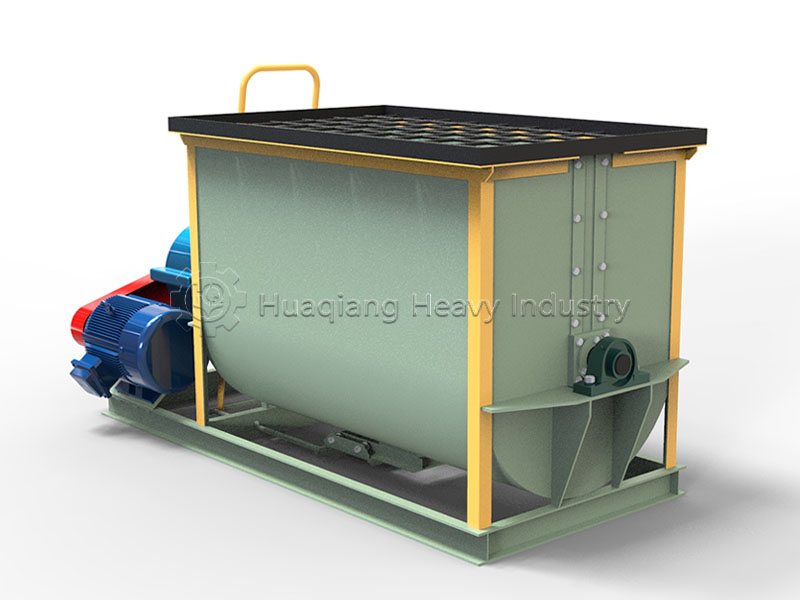Introduction
In the global fertilizer production industry, achieving a homogeneous mixture is crucial for product quality and efficiency. The Horizontal Fertilizer Mixer stands out as a foundational piece of equipment in this process, serving as a critical first step in both a comprehensive NPK fertilizer production line and a specialized organic fertilizer production line. Its robust design and efficient operation are indispensable for ensuring that raw materials are perfectly blended before subsequent processing. This thoroughly mixed material is then ready for granulation, where machinery like a versatile fertilizer granulator takes over. Depending on the production needs, this could be a disc granulator operating within a disc granulation production line for creating spherical pellets, or a double roller press granulator for a dry compaction method. In an NPK fertilizer line specifically, this mixer works in concert with NPK blending machines to create uniform nutrient profiles. The machine’s ability to consistently prepare a wide range of materials ensures that the entire granulation process, regardless of the technology used, produces blends that meet strict quality standards, thereby supporting global food production and sustainable agriculture practices.

Working Principle
The core operation of a horizontal mixer is elegantly simple yet highly effective. It relies on the rotational movement of a mixing device, typically a shaft with blades, inside a horizontally oriented drum.
- Feed:The process begins with the introduction of raw materials—which can include various powders, granules, and additives—through the feed inlet located on top of the mixing drum.
- Mixing:An electric motor drives the central mixing shaft, causing the strategically angled blades to rotate. These blades perform a complex, three-dimensional movement, pushing materials from the center towards the ends of the drum and back. This action creates a turbulent yet controlled environment where particles interact through multiple mechanisms:
- Shearing:Breaking up clumps and ensuring fine particles are incorporated.
- Diffusion:Allowing particles to spread evenly throughout the mixture.
- Convection:Creating bulk movement for large-scale homogeneity.
- Discharge:Once a uniform blend is achieved, which typically takes just a few minutes, the mixed product is discharged through an outlet at the bottom. Many models feature slide gates, butterfly valves, or even screw conveyors for controlled and complete discharge, minimizing residue and cross-contamination between batches.
Key Equipment Features
The horizontal design confers several distinct advantages that make it a preferred choice across industries.
- Superior Mixing Uniformity:The combination of the blade geometry and the horizontal drum orientation ensures that even minor components are distributed evenly throughout the entire batch. This is critical in fertilizer production, where nutrient consistency directly impacts crop yield.
- Remarkable Versatility:This mixer is not limited to fertilizers. It can efficiently handle moist powders, sticky materials, and fragile granules with minimal degradation. Its applicability extends to animal feed, chemicals, pharmaceuticals, and food processing.
- High Capacity for Large-Scale Production:Unlike vertical mixers, the horizontal configuration allows for a much larger volume capacity within a comparable footprint. This makes it ideal for continuous or large-batch production lines, significantly boosting overall plant throughput.
- Ease of Cleaning and Maintenance:The internal components are often easily accessible. Many blades are designed to be removable, and the smooth, uncluttered interior of the drum allows for quick wash-downs, which is essential when switching between different product formulations.
- Excellent Sealing Performance:Advanced sealing systems, such as lip seals or mechanical seals, are employed at the shaft openings. This prevents dust emission, protects the bearings from abrasive particles, and ensures a clean, safe working environment compliant with health and safety regulations.
Conclusion
The Horizontal Fertilizer Mixer is a testament to efficient and reliable industrial design. Its straightforward working principle, coupled with features like high uniformity, large capacity, and easy maintenance, makes it a cornerstone of modern material processing. For any operation requiring consistent, high-volume blending of dry or moist solids, investing in a well-designed horizontal mixer is a strategic step towards optimizing production quality, efficiency, and profitability on a global scale.
Keywords: Fertilizer Mixer, Horizontal Mixer, Mixing Equipment, Industrial Mixer, Fertilizer Production





